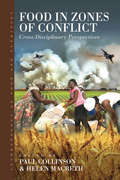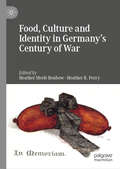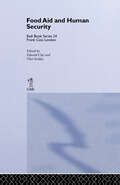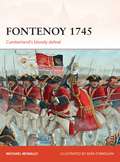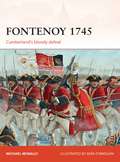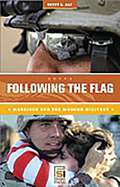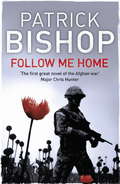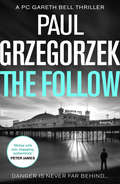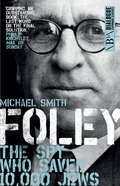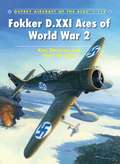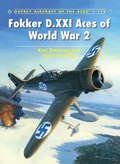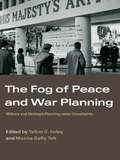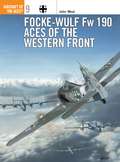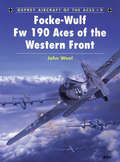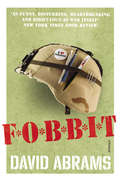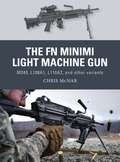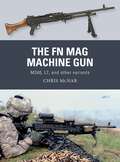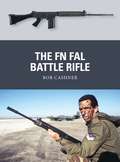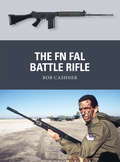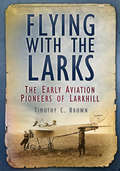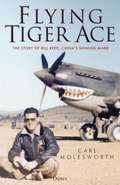- Table View
- List View
Food in Zones of Conflict: Cross-Disciplinary Perspectives (Anthropology of Food & Nutrition #8)
by Paul Collinson Helen MacbethThe availability of food is an especially significant issue in zones of conflict because conflict nearly always impinges on the production and the distribution of food, and causes increased competition for food, land and resources Controlling the production of and access to food can also be used as a weapon by protagonists in conflict. The logistics of supply of food to military personnel operating in conflict zones is another important issue. These themes unite this collection, the chapters of which span different geographic areas. This volume will appeal to scholars in a number of different disciplines, including anthropology, nutrition, political science, development studies and international relations, as well as practitioners working in the private and public sectors, who are currently concerned with food-related issues in the field.
Food, Culture and Identity in Germany's Century of War
by Heather Merle Benbow Heather R. PerryEven in the harsh conditions of total war, food is much more than a daily necessity, however scarce—it is social glue and an identity marker, a form of power and a weapon of war. This collection examines the significance of food and hunger in Germany’s turbulent twentieth century. Food-centered perspectives and experiences “from below” reveal the social, cultural and political consequences of three conflicts that defined the twentieth century: the First and Second World Wars and the ensuing global Cold War. Emerging and established scholars examine the analytical salience of food in the context of twentieth-century Germany while pushing conventional temporal frameworks and disciplinary boundaries. Together, these chapters interrogate the ways in which deeper studies of food culture in Germany can shed new light on old wars.
Food Aid and Human Security (Routledge Research EADI Studies in Development)
by Edward Clay Olav Schram StokkeFood aid is historically a major element of development aid to support longer-term development, and the primary response to help countries and peoples in crisis. This examination of food aid focuses in particular on institutional questions.
Food Aid and Human Security (Routledge Research EADI Studies in Development #No. 24)
by Edward Clay Olav Schram StokkeFood aid is historically a major element of development aid to support longer-term development, and the primary response to help countries and peoples in crisis. This examination of food aid focuses in particular on institutional questions.
Fontenoy 1745: Cumberland's bloody defeat (Campaign #307)
by Michael McNally Seán Ó’BrógáinA disputed succession to the Austrian throne led to general war between the leading powers of Europe in 1740, with France, Spain and Prussia on one side, and Britain, Habsburg Austria and the Dutch Republic on the other. While fighting occurred across the globe, the bloodiest battles were fought on the European continent, with none more costly than the battle of Fontenoy in 1745.Fearing an encirclement of France by a resurgent Habsburg-controlled Austria, the French commander Marshall Saxe planned to overrun the Austrian Netherlands, thereby dealing a decisive blow against their enemy's ability to wage war. Saxe's army, the cream of the French military, invaded and set up a defensive position at Fontenoy, near Tournai – daring his enemies to knock him off his perch. This title, beautifully illustrated with full colour plates, is an in-depth study of the British Duke of Cumberland's attempt to assault Saxe's position. It focuses on the inability of allied leaders to coordinate their attacks and how Cumberland came within a whisker of achieving a major victory.
Fontenoy 1745: Cumberland's bloody defeat (Campaign #307)
by Michael McNally Seán Ó’BrógáinA disputed succession to the Austrian throne led to general war between the leading powers of Europe in 1740, with France, Spain and Prussia on one side, and Britain, Habsburg Austria and the Dutch Republic on the other. While fighting occurred across the globe, the bloodiest battles were fought on the European continent, with none more costly than the battle of Fontenoy in 1745.Fearing an encirclement of France by a resurgent Habsburg-controlled Austria, the French commander Marshall Saxe planned to overrun the Austrian Netherlands, thereby dealing a decisive blow against their enemy's ability to wage war. Saxe's army, the cream of the French military, invaded and set up a defensive position at Fontenoy, near Tournai – daring his enemies to knock him off his perch. This title, beautifully illustrated with full colour plates, is an in-depth study of the British Duke of Cumberland's attempt to assault Saxe's position. It focuses on the inability of allied leaders to coordinate their attacks and how Cumberland came within a whisker of achieving a major victory.
Following the Flag: Marriage and the Modern Military (Praeger Security International)
by Betty L. AltBased on personal interviews with military spouses, as well as current articles and statistics and studies from the Department of Defense and Rand National Defense Research Institute, this book provides an objective look at America's military family in the 21st century, and explains how the military is attempting to improve family life. Following the Flag discusses both the problems and perks of today's armed forces families. It particularly looks at the military family since America has become involved in peace-keeping missions in Africa and combat in Afghanistan and Iraq. Studies on family stress connected with deployment (depression, divorce, domestic violence) are presented. A special focus is the families of the National Guard and Reserves who are often unprepared, emotionally and financially, for family members to be called to duty.In addition, the book provides current information on nontraditional military families. These include female military personnel married to civilian males, who many times must place their careers second and follow their wives to new assignments, and families where both spouses are military personnel who can be deployed at any time.Many changes have occurred in the American armed forces over the past three decades. An all-volunteer military came into being after the end of conscription in 1973; women have joined the force in ever increasing numbers; service personnel today are again involved in combat situations around the world; reserve and guard units have been called to active duty. With these developments, the role of military families has changed as well. This book explains what the those changes have been, and what they have meant to the families involved.
Follow Me Home
by Patrick BishopHigh summer in Helmand Province, Afghanistan.Two young soldiers, Milo and Zac, are on a mission which could really make their names. Their special duties team is to ambush and capture a notorious Taliban leader.The operation has been meticulously planned and set up. But suddenly - all is chaos.The hunters are now the hunted. To reach safety they must make their way through fifty kilometres of hostile territory, with a Taliban captive and a young, frightened woman in tow. Perilous at every turn, the journey is the biggest test any of them has ever faced, and it will change their lives forever.
The Follow (Gareth Bell Thriller #1)
by Paul Grzegorzek‘Writes with raw, engaging, authenticity’ Peter James A fast-paced and riveting crime novel and the first in a new Brighton-set police procedural series featuring PC Gareth Bell. Perfect for fans of Peter James. Danger is never far behind…
Foley: The Spy Who Saved 10,000 Jews
by Michael SmithAs the horror of Nazism tightened its grip on Germany, Jews found themselves trapped and desperate. For many, their only hope of salvation came in the form of a small, bespectacled British man: Frank Foley. Working as a Berlin Passport Control Officer, Foley helped thousands of Jews to flee the country with visas and false passports, personally entering the camps to get Jews out, and sheltering those on the run from the Gestapo in his own apartment. Described by a Jewish leader as 'the Pimpernel of the Jews', Foley was an unsung hero of the Holocaust. But why is this extraordinary man virtually unknown, even in Britain?The reason is simple: Foley was MI6 head of station in Berlin, bound to secrecy by the code of his profession. Michael Smith's work uncovering the remarkable truth led to the recognition of Frank Foley as Righteous Among Nations, the highest honour the Jewish state can bestow upon a Gentile. Foley is a story of courage and quiet heroism in the face of great evil - a reminder of the impact that one brave individual can have on the lives of many.
Fokker D.XXI Aces of World War 2 (Aircraft of the Aces)
by Chris Davey Kari Stenman Mark Postlethwaite Peter De JongThe Dutch D.XXIs saw less than a week of action following the German invasion of the west on 10 May 1940, with many of the country's 28 fighters being destroyed on the ground. However, those that survived the initial onslaught inflicted losses on the Luftwaffe. By then, however, the D.XXI had found everlasting fame in Finland during the Winter War of 1939-40. Proving itself a real thorn in the side of the Soviets, the fighter, operating in primitive conditions and against vastly superior numbers, Finnish D.XXIs racked up an incredible score against the Red Air Force. The D.XXI also has the distinction of producing the first 'ace in a single mission' in World War 2, when then 1Lt Jorma Sarvanto shot down six Ilyushin DB-3 bombers on 6 January 1940. After spending a year providing home defence and flying coastal patrols during the early stages of the Continuation War in 1941, all surviving Finnish Fokker D.XXIs were relegated to the reconnaissance role, which they performed through to the end of hostilities in September 1944.
Fokker D.XXI Aces of World War 2 (Aircraft of the Aces #112)
by Kari Stenman Peter De Jong Mr Chris Davey Mr Mark PostlethwaiteThe Dutch D.XXIs saw less than a week of action following the German invasion of the west on 10 May 1940, with many of the country's 28 fighters being destroyed on the ground. However, those that survived the initial onslaught inflicted losses on the Luftwaffe. By then, however, the D.XXI had found everlasting fame in Finland during the Winter War of 1939-40. Proving itself a real thorn in the side of the Soviets, the fighter, operating in primitive conditions and against vastly superior numbers, Finnish D.XXIs racked up an incredible score against the Red Air Force. The D.XXI also has the distinction of producing the first 'ace in a single mission' in World War 2, when then 1Lt Jorma Sarvanto shot down six Ilyushin DB-3 bombers on 6 January 1940. After spending a year providing home defence and flying coastal patrols during the early stages of the Continuation War in 1941, all surviving Finnish Fokker D.XXIs were relegated to the reconnaissance role, which they performed through to the end of hostilities in September 1944.
The Fog of Peace and War Planning: Military and Strategic Planning under Uncertainty (Strategy and History #Vol. 12)
by Talbot C. Imlay Monica Duffy ToftHow do we plan under conditions of uncertainty? The perspective of military planners is a key organizing framework: do they see themselves as preparing to administer a peace, or preparing to fight a future war? Most interwar volumes examine only the 1920s and the 1930s. This new volume goes back, and forward in time, to draw on a greater expanse of history in order to tease out lessons for contemporary planners.These chapters are grouped into four periods: 1815-1856, 1871-1914, 1918-1938, and post-Second World War. They progress from low-tech to high-tech concerns, for example, the first period examines armies, while the second period examines navies, the third asseses navies combined with air forces, and finally for the Kaiser chapter explores nuclear issues and decision-making.
The Fog of Peace and War Planning: Military and Strategic Planning under Uncertainty (Strategy and History)
by Talbot C. Imlay Monica Duffy ToftHow do we plan under conditions of uncertainty? The perspective of military planners is a key organizing framework: do they see themselves as preparing to administer a peace, or preparing to fight a future war? Most interwar volumes examine only the 1920s and the 1930s. This new volume goes back, and forward in time, to draw on a greater expanse of history in order to tease out lessons for contemporary planners.These chapters are grouped into four periods: 1815-1856, 1871-1914, 1918-1938, and post-Second World War. They progress from low-tech to high-tech concerns, for example, the first period examines armies, while the second period examines navies, the third asseses navies combined with air forces, and finally for the Kaiser chapter explores nuclear issues and decision-making.
Focke-Wulf Fw 190 Aces of the Western Front (Aircraft of the Aces #9)
by John WealThe Fw 190 was the scourge of Fighter Command from the moment it appeared on the Western Front at Abbeville in August 1941 with II./JG 26. A nimble, speedy and well-armed adversary, the 'Butcher Bird' quickly proved superior to all Allied fighters of the time, particularly at medium to low altitude. Led by Experten of the calibre of 'Pips' Priller, Heinz Bar and Walter Oesau, the handful of Fw 190-equipped Jagdgeschwader flew against overwhelming odds, firstly on the Channel coast, and then in direct defence of the Reich when the Jagdflieger took on the might of the USAAF's Eighth and Ninth Air Forces. This is their story.
Focke-Wulf Fw 190 Aces of the Western Front (Aircraft of the Aces #9)
by John WealThe Fw 190 was the scourge of Fighter Command from the moment it appeared on the Western Front at Abbeville in August 1941 with II./JG 26. A nimble, speedy and well-armed adversary, the 'Butcher Bird' quickly proved superior to all Allied fighters of the time, particularly at medium to low altitude. Led by Experten of the calibre of 'Pips' Priller, Heinz Bar and Walter Oesau, the handful of Fw 190-equipped Jagdgeschwader flew against overwhelming odds, firstly on the Channel coast, and then in direct defence of the Reich when the Jagdflieger took on the might of the USAAF's Eighth and Ninth Air Forces. This is their story.
Fobbit
by David AbramsFobbit ’fä-b t, noun. Definition: A U.S. soldier stationed at a Forward Operating Base who avoids combat by remaining at the base, esp. during Operation Iraqi Freedom (2003–2011). Pejorative. Welcome to the FOB – Baghdad’s Forward Operating Base Triumph. This is the back-office of the battlefield, where Staff Sergeant Chance Gooding (a Fobbit through and through) spends his days tapping out press releases to turn the latest roadside bomb into something the folks back home can read about over their breakfast cereal. This is where male and female soldiers are trying to find an empty Porta-Potty in which to get acquainted, grunts are playing Xbox between missions, and most of the senior staff are more concerned about getting to the chow hall in time for the Friday night all-you-can-eat seafood special than worrying about little things like military strategy. This is where things can very quickly spiral out of control.
The FN Minimi Light Machine Gun: M249, L108A1, L110A2, and other variants (Weapon)
by Johnny Shumate Chris McNab Alan GillilandIn 1974, renowned Belgian arms company Fabrique Nationale brought out a ground-breaking new light machine gun, the Minimi. Its success has been meteoric, arming more than 45 countries around the world.The Minimi offers the ultimate in portable firepower. Firing the high-velocity 5.56×45mm round, the Minimi is a gas-operated, lightweight, belt- or magazine-fed weapon, able to burn through cartridges at a cyclical rate of up to 1,150 rounds per minute, making it the weapon of choice for fire support at squad level.This study uses gripping first-hand accounts and striking combat photographs, following the Minimi to war zones such as Iraq and Afghanistan. It tracks its design and development, as well as investigating what has made it so compelling a choice for armed forces around the world for more than 40 years.
The FN Minimi Light Machine Gun: M249, L108A1, L110A2, and other variants (Weapon)
by Johnny Shumate Chris McNab Alan GillilandIn 1974, renowned Belgian arms company Fabrique Nationale brought out a ground-breaking new light machine gun, the Minimi. Its success has been meteoric, arming more than 45 countries around the world.The Minimi offers the ultimate in portable firepower. Firing the high-velocity 5.56×45mm round, the Minimi is a gas-operated, lightweight, belt- or magazine-fed weapon, able to burn through cartridges at a cyclical rate of up to 1,150 rounds per minute, making it the weapon of choice for fire support at squad level.This study uses gripping first-hand accounts and striking combat photographs, following the Minimi to war zones such as Iraq and Afghanistan. It tracks its design and development, as well as investigating what has made it so compelling a choice for armed forces around the world for more than 40 years.
The FN MAG Machine Gun: M240, L7, and other variants (Weapon)
by Johnny Shumate Chris McNab Alan GillilandFor six decades, the 7.62mm FN MAG has been a dominant general-purpose machine gun (GPMG) in worldwide arsenals. Three qualities have guaranteed this enduring status – reliability, ease of operation, and firepower. Several nations have license-produced the weapon as their standard GPMG, including the British (as the L7) and the Americans (M240), and in total more than 80 nations have adopted the FN MAG. The machine gun has also been modified extensively for vehicular, naval, and aircraft platforms, demonstrating versatility in the air, on sea, and on land.In this book, Chris McNab charts the technical evolution of this extraordinary weapon, created by Belgian company Fabrique Nationale d'Herstal. From the jungles of South East Asia, to the deserts of the Middle East, and the icy battlefields of the Falklands, this study explores the origins, development, combat use, and legacy of the FN MAG machine gun, a dominant weapon in its field for more than a half-century.
The FN MAG Machine Gun: M240, L7, and other variants (Weapon #63)
by Johnny Shumate Chris McNab Alan GillilandFor six decades, the 7.62mm FN MAG has been a dominant general-purpose machine gun (GPMG) in worldwide arsenals. Three qualities have guaranteed this enduring status – reliability, ease of operation, and firepower. Several nations have license-produced the weapon as their standard GPMG, including the British (as the L7) and the Americans (M240), and in total more than 80 nations have adopted the FN MAG. The machine gun has also been modified extensively for vehicular, naval, and aircraft platforms, demonstrating versatility in the air, on sea, and on land.In this book, Chris McNab charts the technical evolution of this extraordinary weapon, created by Belgian company Fabrique Nationale d'Herstal. From the jungles of South East Asia, to the deserts of the Middle East, and the icy battlefields of the Falklands, this study explores the origins, development, combat use, and legacy of the FN MAG machine gun, a dominant weapon in its field for more than a half-century.
The FN FAL Battle Rifle (Weapon)
by Steve Noon Bob CashnerOf all the infantry small arms developed during World War II, one that generated the most interest was the German 'assault rifle', the StG 44 Sturmgewehr. This innovative weapon inspired the Soviet AK-47 in 7.62x39mm calibre. In the West, the NATO countries looked hard at new weapons to upgrade their own infantry arsenals and counter the AK-47, resulting in the design of the Fusil Automatique Léger or FAL. It proved to be a successful battle rifle and was soon adopted by the military and police forces of no fewer than 93 nations. The FAL dominated the militaries of the West to such a degree that its nickname became the Right Arm of the Free World. The FAL fulfilled every role it was asked to perform and remains a viable and well-respected weapon to this day.
The FN FAL Battle Rifle (Weapon)
by Steve Noon Bob CashnerOf all the infantry small arms developed during World War II, one that generated the most interest was the German 'assault rifle', the StG 44 Sturmgewehr. This innovative weapon inspired the Soviet AK-47 in 7.62x39mm calibre. In the West, the NATO countries looked hard at new weapons to upgrade their own infantry arsenals and counter the AK-47, resulting in the design of the Fusil Automatique Léger or FAL. It proved to be a successful battle rifle and was soon adopted by the military and police forces of no fewer than 93 nations. The FAL dominated the militaries of the West to such a degree that its nickname became the Right Arm of the Free World. The FAL fulfilled every role it was asked to perform and remains a viable and well-respected weapon to this day.
Flying With the Larks: The Early Aviation Pioneers of Larkhill
by Timothy C. BrownIn 1903 the Wright Brothers achieved their dream of powered flight and from then on man’s domination of the skies became a reality. The military potential of aircraft was obvious from the outset, first as a way of spying on the enemy with reconnaissance planes and balloons armed with early cameras, and then as a way of taking the battle into the skies, as planes became weapons of war. In Britain these early days of military aviation were pioneered by a group of enthusiastic civilians and military men who were based at Lark Hill, Wiltshire where the rolling plains became ideal flying grounds. Here, the first military aviation base came into existence. Flying with the Larks charts its early days and its influence on First World War aviation.
Flying Tiger Ace: The story of Bill Reed, China’s Shining Mark
by Carl MolesworthBill Reed had it all – brains, looks, athleticism, courage and a talent for leadership. After a challenging childhood in Depression-era Iowa, Reed joined the US Army Air Corps, but the outbreak of World War II saw him give up his commission. Instead, he travelled to China to fly for the American Volunteer Group – the legendary Flying Tigers. After a brief return to America, he resumed the fight as a senior pilot and later squadron commander in the Chinese-American Composite Wing. Soon afterwards, Reed tragically lost his life in a desperate parachute jump late in the war, by which point he was a fighter ace with nine confirmed aerial victories. His obituary was front-page news throughout the state of Iowa. This book is a biography of his extraordinary life, focusing on his time spent flying with some of the famous aerial groups of World War II. It draws heavily on Reed's own words, along with the author's deep knowledge of the China air war and years of research into Reed's life, to tell his compelling story.
